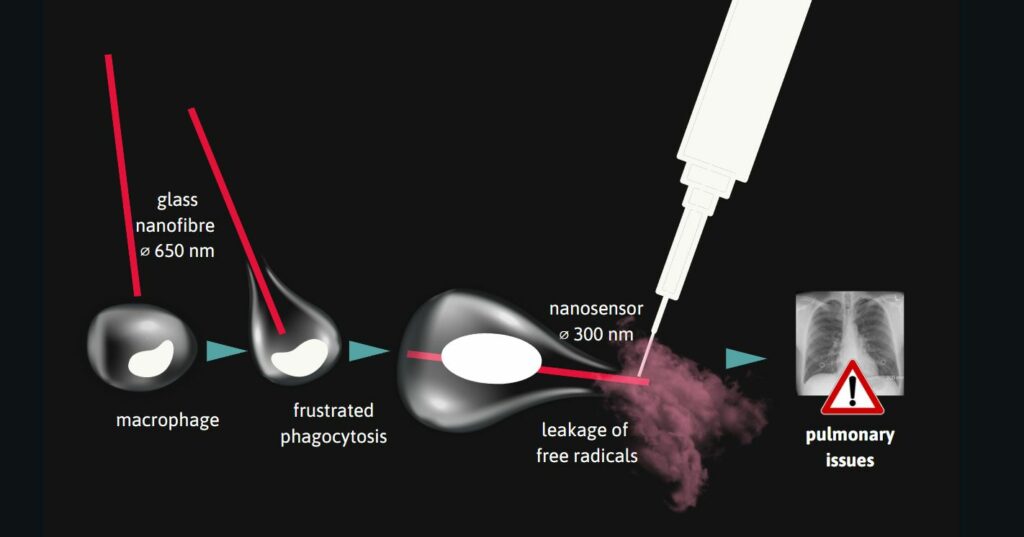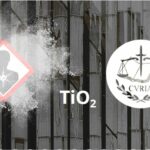
Asbestos, nanofibres and glass wool: all the same damage?
A study published in Nature Nanotechnology shows how long glass nanofibers cause deleterious effects in the lungs, and lifts the veil on the mechanism responsible for damage similar to that identified for asbestos fibers: the leakage of free radicals, demonstrated for the first time using electrochemical nanosensors. These results serve as a reminder of the need for vigilance in the use of nano-sized and fiber particles, even those that do not fall under the strict definition of “nanomaterials”.
Nanosensors make the effects of nanofibers visible
Glass nanofibers have already been identified as harmful to the lungs of those who inhale them1 Cf. Fibers other than asbestos – what you need to know (web page) and Dossier complet “Fibres autres que l’amiante” (pdf file), INRS, 2023. A new study published in early January in the journal Nature Nanotechnology showed, literally AND figuratively, how the thinnness and length of glass nanofibers play a part in their dangerousness: not only do they prevent macrophages from playing their essential cleansing role, but they also trigger reactions that cause serious lung problems.
The study was carried out in China, under the co-direction of Christian Amatore, director of research emeritus at CNRS (France), and Wei-Hua Huang of Wuhan University. It took place in two stages:
1 – The first phase of an experiment in vitro has shown that macrophages are unable to completely surround glass nanofibers over 15 microns in length (with an average diameter of around 650 nm), and so are unable to eliminate them – literally and figuratively once again.
→ Above all, for the first time, thanks to electrochemical nanosensors consisting of electrodes around 300 nm in diameter2For more information on how these nanosensors work, see Homeostasis inside Single Activated Phagolysosomes: Quantitative and Selective Measurements of Submillisecond Dynamics of Reactive Oxygen and Nitrogen Species Production with a Nanoelectrochemical Sensor, Qi YT et al, J. Am. Chem. Soc., 144, 9723-9733, 2022, the researchers were able to identify and measure the mechanism responsible for this “frustrated phagocytosis”: leakage of free radicals (reactive oxygen species (ROS) and reactive nitrogen species (RNS)). While these are useful in enabling our immune system to destroy pathogens (such as viruses or bacteria) or altered cells, they are very harmful to the alveolar wall.
2 – Another experiment, this time carried out in vivo on rats, confirmed that regular inhalation of the same type of glass nanofibers, of comparable shape and size, generates inflammation and lung damage, with a consequent risk of developing fibrosis.
Particle size and morphology are key toxicity parameters
Interviewed by AVICENN, the only French member of the team who led this work, Christian Amatore, Emeritus Research Director at the CNRS, recalls that he worked at Jussieu (whose asbestos removal project was the largest ever carried out in Europe, at a cost of 1.7 billion euros)3Cf. Asbestos removal on the Jussieu campus, Ecolex, November 2020 and probably a hundred deaths by 20504 Cf. À Jussieu, l’amiante fera 100 morts à terme, Le Figaro, 2016). “As a chemist, I had long wanted to understand how asbestos causes cancer; research shows that the elongated shape of nanofibers is a determining factor, even more so than chemical composition”.
Marie-Claude Jaurand, who did not take part in the study but has long worked on the effects of asbestos as laboratory director at INSERM, attests that “these results confirm and illustrate, using more modern methods, what was known but not so precisely or visibly” .
In her opinion, more studies should be carried out to refine and complete these results – for example, by comparing short and long fibers, which is not possible due to the lack of funding for public toxicology research in France (which is why Mr. Amatore had to carry out these experiments in China).
Asbestos, glass nanofibres and glass wool: what are the differences?
In the initial version of the CNRS press release published in early January to publicize the study’s publication in Nature Nanotechnology, the uses and effects of glass fibers were compared with those of glass wool and asbestos. On January 19, Ouest-France reported that the national union of mineral wool insulation manufacturers (Filmm) had asked the CNRS to remove the term “glass wool”5Cf. Laine de verre et santé : passe d’armes entre le CNRS et les fabricants, Ouest-France, January 19, 2024 on the grounds that “the fibers in mineral wool insulation are made up of long threads visible to the eye, and therefore not nanometric. Their diameter is between 3 and 5 µm” – which is indeed larger than the glass nanofibers studied by the Franco-Chinese team. The correction has been made (and a reference to carbon nanotubes has been added). But what are the differences between these different mineral fibres?
Different asbestos fibers have diameters ranging from 20 to 100 nanometers and lengths from 40 Whto 70 millimeters6 Cf. What is asbestos? (web page), INRS, 2022They are therefore much thinner and longer than the glass fibers studied by Christian Amatore and Wei-Hua Huang’s team.
The use of glass wool has developed in the building sector, notably for its thermal insulation properties, which have been particularly sought-after since the 1997 ban on asbestos (whose death toll from cancer could exceed 100,000 by 2050)7Cf. L’amiante : un sujet toujours d’actualité, Anses, February 7, 2023). According to INRS, glass wool has an average diameter of between 2 and 8 µm8Cf. reference in note 1. As for glass nanofibers, again according to the INRS, their insulating properties are more confined to the aerospace and aeronautics sectors; on the other hand, they are widely used in many filtration systems, thanks to their thinness. Their diameter is generally less than 3 µm, and can even be as small as 0.1 µm (i.e. 100 nm9)Cf. reference in note 1.
Vigilance is essential in all cases
The hazards of different man-made mineral fibers (MMMFs) are somewhat different10Dossier complet “Fibres autres que l’amiante” (dossier pdf), INRS, 2023: glass wools are classified as category 2 carcinogens under the CLP regulation if they are biopersistent or less than 6 µm in diameter. Glass microfibers are very thin, most of them less than 6 µm in diameter, and are classified as category 1B or 2 carcinogens when biopersistent.
But Christian Amatore believes that beyond the question of nano or micro size, the issue of health risks should be taken seriously: “glass or rock wool deteriorates when handled” and “inhalation of aerosols of their microscopic debris could be harmful”. In fact, although significantly different, the long, fibrous shapes and sizes of asbestos, long carbon nanotubes and glass nanofibers are likely to cause harmful effects. This is why the INRS recommends selecting products and work methods that minimize fiber and dust emissions.11Cf. Fiche pratique de sécurité – Laines minérales d’isolation, bonnes pratiques d’isolation – ED93, INRS, 2013 ; Servicing and maintenance operations likely to emit asbestos fibres – Prevention guide – ED 6262, INRS, 2016 ; Carbon nanotubes: what risks, what prevention? ND2286, INRS, 2008 ; Dossier complet Amiante (pdf file), INRS, 2023.
Further research would be needed to clarify the hazard of these different fibers, in particular to compare the cellular responses provoked by exposure to asbestos fibers with those of exposure to glass fibers, glass wools and long carbon nanotubes12The International Agency for Research on Cancer (Circ) classified a type of multiwall carbon nanotube as “possibly carcinogenic to humans” (2B) in 2017, and the European Chemicals Agency (ECHA) validated in 2022 the principle of classifying long multiwall carbon nanotubes as carcinogenic by inhalation (cat. 1B) for example13An INRS study recently revealed that short, thin carbon nanotubes also induce acute pulmonary inflammation, as well as chronic inflammation and hyperplasia. (abnormal proliferation) in the lungs. Cf. our article: “Carbon nanotubes: beware, the courts too can be toxic“, VeilleNanos, November 2023. The safety conditions required for handling asbestos fibers are such that they call for dedicated laboratories and equipment, as well as specially trained personnel. Unfortunately, public-sector laboratories do not currently have the appropriate infrastructure or funding.14In the current context of budget restrictions, Santé Publique France may even be on the point of discontinuing mesothelioma surveillance for lack of sufficient resources. Such a decision would do away with an essential tool for better understanding and combating this terrible disease specific to asbestos,” denounces the Association nationale de défense des victimes de l’amiante (Andeva). Cf. No to the death of the national mesothelioma surveillance system!Andeva, January 26, 2024.. And while prevention could save many resources by preventing future illnesses, the Ministry of Labor’s draft circular on nanomaterials, dusts and fibers has still not been published. Announced as imminent a few years ago, we’re still waiting for it…

Nos autres actus nano
Les prochains RDV nano
- 8th Congress of Occupational Medicine and Health (CNMST 2026)
- Theme 5: Emerging pathologies and risks, Mr Henri Bastos (ANSES), Pr Lynda Bensefa-Colas (AP-HP), Dr Catherine Nisse (CHU Lille)
- Website: www.medecine-sante-travail.com
- 20th meeting of the “nano and health” dialogue committee
- Organizer: ANSES
- Training intended for occupational physicians, occupational risk prevention specialists (IPRP), company prevention specialists, prevention department staff from Carsat, Cramif and CGSS, institutional prevention specialists (Dreets, Dreal, MSA…).
- Organizer: French National institute of research and security (INRS)
- October 5 to 9, 2026
- Website: www.inrs.fr/…/formation/…JA1030_2026
Notes and references
- 1Cf. Fibers other than asbestos – what you need to know (web page) and Dossier complet “Fibres autres que l’amiante” (pdf file), INRS, 2023
- 2For more information on how these nanosensors work, see Homeostasis inside Single Activated Phagolysosomes: Quantitative and Selective Measurements of Submillisecond Dynamics of Reactive Oxygen and Nitrogen Species Production with a Nanoelectrochemical Sensor, Qi YT et al, J. Am. Chem. Soc., 144, 9723-9733, 2022
- 3Cf. Asbestos removal on the Jussieu campus, Ecolex, November 2020
- 4Cf. À Jussieu, l’amiante fera 100 morts à terme, Le Figaro, 2016)
- 5Cf. Laine de verre et santé : passe d’armes entre le CNRS et les fabricants, Ouest-France, January 19, 2024
- 6Cf. What is asbestos? (web page), INRS, 2022
- 7Cf. L’amiante : un sujet toujours d’actualité, Anses, February 7, 2023
- 8Cf. reference in note 1
- 9)Cf. reference in note 1
- 10Dossier complet “Fibres autres que l’amiante” (dossier pdf), INRS, 2023
- 11Cf. Fiche pratique de sécurité – Laines minérales d’isolation, bonnes pratiques d’isolation – ED93, INRS, 2013 ; Servicing and maintenance operations likely to emit asbestos fibres – Prevention guide – ED 6262, INRS, 2016 ; Carbon nanotubes: what risks, what prevention? ND2286, INRS, 2008 ; Dossier complet Amiante (pdf file), INRS, 2023
- 12The International Agency for Research on Cancer (Circ) classified a type of multiwall carbon nanotube as “possibly carcinogenic to humans” (2B) in 2017, and the European Chemicals Agency (ECHA) validated in 2022 the principle of classifying long multiwall carbon nanotubes as carcinogenic by inhalation (cat. 1B)
- 13An INRS study recently revealed that short, thin carbon nanotubes also induce acute pulmonary inflammation, as well as chronic inflammation and hyperplasia. (abnormal proliferation) in the lungs. Cf. our article: “Carbon nanotubes: beware, the courts too can be toxic“, VeilleNanos, November 2023
- 14In the current context of budget restrictions, Santé Publique France may even be on the point of discontinuing mesothelioma surveillance for lack of sufficient resources. Such a decision would do away with an essential tool for better understanding and combating this terrible disease specific to asbestos,” denounces the Association nationale de défense des victimes de l’amiante (Andeva). Cf. No to the death of the national mesothelioma surveillance system!Andeva, January 26, 2024.



